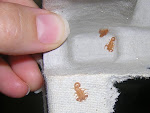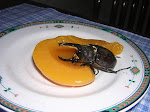
{Continuation from previous post}
So what killed Eric York, Grand Canyon National Park wildlife biologist, were aerosolized droplets of primary pneumonic plague that he breathed (through his unmasked mouth and nose) while doing a necropsy on an infected mountain lion. The photos he took while doing this -- with ungloved hands -- serve as sort of a morbid documentation of his infection, which resulted in his untimely death just days later. As I sat in a conference listening to the details, viewing the photos this week, I got squirmy. Oh to go back and warn him...
Individuals have to take responsibility for their own health precautions – that is true. But when you're exhausted and everything is going wrong (and in the field everything regularly goes wrong), it’s the path of least resistance to let your own safety slide in favor of accomplishing the work. It's especially true when education and awareness about protecting one’s self isn’t properly addressed (or addressed at all, perhaps) by one’s employer. Being encouraged to tuck a wild animal into my shirt to keep it warm while it crapped and bled all over me wasn't something I thought twice about at the time, given the circumstances. I guess we'll never know where Eric York stood on the continuum of exhaustion, things going wrong, and the slippery slope of relinquishing caution, or what role any of that played in his mind.
The preventability of
Ironically,  transmission of pneumonic plague to other humans at Grand Canyon National Park. While he never knew it, he probably saved a lot of lives. It was nice to hear the U.S. Public Health Service medical doctor honor him during the conference this week, while admitting "we got lucky" that no outbreak occurred. By all other accounts as well, it sounds like his passing is a recognized loss to international research for the study and protection of wild cats.
transmission of pneumonic plague to other humans at Grand Canyon National Park. While he never knew it, he probably saved a lot of lives. It was nice to hear the U.S. Public Health Service medical doctor honor him during the conference this week, while admitting "we got lucky" that no outbreak occurred. By all other accounts as well, it sounds like his passing is a recognized loss to international research for the study and protection of wild cats.
If you’d like to honor the life or passing of wildlife biologist Eric York, apparently you can donate to the Felidae Conservation Fund -- an organization with whom he collaborated on domestic and international research projects toward the protection of wild cats.
Felidae Conservation Fund
www.felidaefund.org/about_us/memorial
+reduced.jpg)


No comments:
Post a Comment